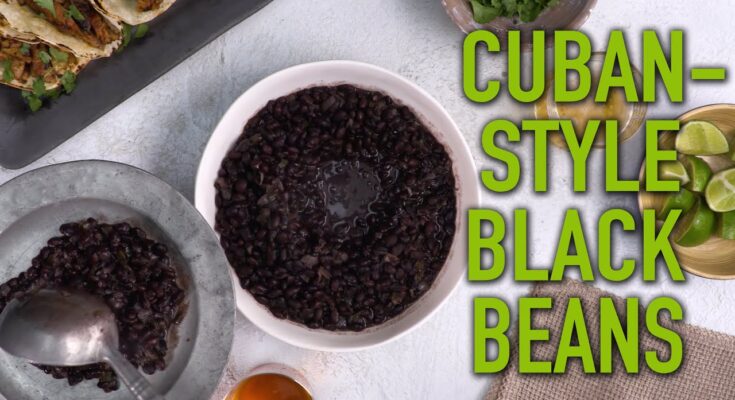Cuban Black Beans Recipe: Cuban black beans, known as frijoles negros, are more than just a side dish—they’re a beloved staple across Cuban households. Their deep, earthy flavor and creamy texture make them a comforting classic, and they’re packed with cultural heritage. Whether served alongside rice, in soups, or as a standalone dish, these beans symbolize the heart of Cuban comfort food. If you’ve ever tasted authentic Cuban cuisine, chances are you’ve already been introduced to this rich, soulful dish.
What makes Cuban black beans so iconic? It’s the blend of simple ingredients like onion, garlic, green pepper, and spices, all simmered to create a dish that feels like a warm hug. Unlike other bean recipes, Cuban black beans are mildly spiced, with flavors that develop slowly and richly as they cook. They’re both humble and full of depth—perfect for weekday dinners or special gatherings.
Nutritional Benefits of Black Beans
Black beans are not just tasty—they’re a powerhouse of nutrition. One cup of cooked black beans offers nearly 15 grams of protein and a healthy dose of fiber, making them great for digestion and satiety. They’re low in fat, high in complex carbohydrates, and loaded with antioxidants. For anyone seeking to improve heart health or stabilize blood sugar levels, black beans are a smart choice.
Additionally, these beans are rich in folate, iron, magnesium, and potassium—key nutrients your body needs to function at its best. Whether you’re vegetarian, vegan, or just trying to eat cleaner, Cuban black beans can be a nutritious part of your regular meal rotation.
Ingredients You’ll Need
Main Ingredients
Here’s a quick list of what you’ll need to bring this flavorful dish to life. Stick with the basics if it’s your first time, or tweak as you go once you’ve mastered the classic method:
- 1 pound dried black beans (or 2 cans if you’re in a pinch)
- 1 medium green bell pepper, finely chopped
- 1 medium onion, diced
- 4 garlic cloves, minced
- 2 tablespoons olive oil
- 1 bay leaf
- 1 teaspoon dried oregano
- 1 teaspoon ground cumin
- 1 tablespoon white vinegar
- 1 tablespoon sugar (balances acidity)
- Salt and black pepper, to taste
- 6–7 cups water (for dried beans)
Each ingredient plays a role: the olive oil softens the veggies, the garlic and onion create the base, and the spices elevate the flavor to bold and irresistible levels.
Optional Add-Ins for Extra Flavor
Want to make it even more authentic or give it your personal touch? Try these additions:
- Chopped cilantro (for garnish and added aroma)
- Dash of hot sauce or red pepper flakes
- Diced tomatoes for a tangy twist
- Ham bone or bacon (for meat lovers)
- Sofrito (a traditional blend of sautéed onions, garlic, and peppers)
These are not must-haves, but they’ll elevate the dish depending on your taste preferences.
Kitchen Tools Required
Basic Cooking Tools
You don’t need fancy gadgets to make Cuban black beans, but a few kitchen staples make the job smoother:
- Large stockpot or Dutch oven
- Cutting board and sharp knife
- Wooden spoon or spatula
- Measuring spoons
- Colander (for rinsing beans)
A heavy-bottomed pot is particularly helpful, as it distributes heat evenly and prevents the beans from burning or sticking during the simmering stage.
Recommended Add-ons for Convenience
If you want to speed up or simplify the process:
- Pressure cooker or Instant Pot – Cuts cooking time in half.
- Blender or immersion blender – If you want creamier beans or a bean puree.
- Garlic press – For quick mincing.
Having these on hand isn’t necessary, but they’re handy for anyone planning to make beans more than once a week.
Step-by-Step Cooking Instructions
Step 1: Soaking the Beans
If you’re using dried beans, soaking is the crucial first step.
Why soak? It reduces cooking time, helps with digestion, and ensures your beans cook evenly. Here’s how:
- Quick soak method: Place beans in a pot, cover with water, bring to a boil for 2 minutes, then let sit for 1 hour.
- Overnight soak: Rinse the beans and cover them with water, let them sit at room temperature for 8–12 hours.
After soaking, drain and rinse the beans well. This removes some of the indigestible sugars that cause bloating. If you’re using canned beans, skip this step and rinse them thoroughly to reduce sodium.
Step 2: Sautéing the Aromatics
This step is where the flavor starts to build. Heat olive oil in a large pot over medium heat.
- Add the chopped onions, garlic, and green pepper.
- Cook until the onion becomes translucent and the garlic is fragrant—about 5–7 minutes.
- Add the cumin, oregano, and bay leaf, stirring well to coat the veggies with the spices.
This base is called sofrito in Cuban cooking. It’s what transforms a pot of beans into a comforting, flavor-packed masterpiece. Once you smell that savory aroma, you know it’s going to be good.
Step 3: Simmering to Perfection
Now it’s time to bring everything together.
- Add the soaked beans and 6–7 cups of water to the pot.
- Bring to a boil, then lower the heat to a gentle simmer.
- Cover and cook for 1.5 to 2 hours, stirring occasionally. Keep an eye on the water level and add more if needed.
About 20 minutes before the beans are done, stir in the sugar, vinegar, salt, and pepper. Taste and adjust the seasoning.
Optional tip: To thicken the beans, mash a few of them against the side of the pot and stir. This releases starch and gives the beans a creamier consistency.
Serving Suggestions
Classic Pairings
Cuban black beans are best enjoyed with the classics. The number one companion? White rice—fluffy, hot, and the perfect base to soak up those rich, savory beans. This pairing, known as Moros y Cristianos (Moors and Christians), is a cultural icon in Cuban cuisine. The mildness of the rice balances the depth of the beans perfectly.
Another go-to side is fried sweet plantains (maduros). Their caramelized sweetness is the ideal contrast to the earthy bean flavors. Add some mojo-marinated pork or ropa vieja (shredded beef) on the side, and you’ve got a Cuban feast worthy of a celebration.
For vegetarians, pair black beans with grilled vegetables, avocado slices, or even a light tropical salad featuring pineapple, mango, or papaya. These ingredients keep the meal light while complementing the beans beautifully.
Here’s a traditional Cuban meal combo to try:
- Black beans
- White rice
- Fried plantains
- Grilled pork chop or tofu
- Avocado and tomato salad
Creative Ways to Serve Cuban Black Beans
Looking to mix things up? There are endless ways to enjoy leftover Cuban black beans beyond the standard plate of rice:
- Taco or burrito filling: Add beans, some sautéed veggies, and cheese into a tortilla.
- Breakfast bowl: Top with a fried egg, avocado, and salsa for a hearty morning meal.
- Black bean soup: Blend a portion of the beans for a thicker consistency, season to taste, and serve with crusty bread.
- Black bean burgers: Mash the beans, add breadcrumbs, onion, spices, and form patties for a plant-based burger.
- Stuffed peppers: Mix beans with rice and cheese, then stuff into bell peppers and bake until bubbly.
Cuban black beans are incredibly versatile. They freeze well, reheat like a charm, and pair wonderfully with both bold and mild ingredients. Whether you’re meal-prepping for the week or cooking for a crowd, these beans have your back.
Tips and Tricks for Perfect Cuban Black Beans
Taste as You Go
Don’t be afraid to adjust as you cook. Cuban food isn’t about strict rules—it’s about flavor and feel. Maybe you like more garlic or less cumin? Go for it. Make it yours.
Don’t Overdo the Salt Early On
Adding too much salt at the start can toughen the beans. Always wait until the last 30 minutes of simmering to add salt. This lets the beans cook properly while still soaking up flavor near the end.
Use Homemade Stock for Extra Flavor
Want a boost of savory richness? Swap out a few cups of water for vegetable or chicken stock. It deepens the flavor and gives the beans a subtle umami edge.
Make It Ahead
Black beans taste even better the next day. Letting them sit overnight in the fridge allows the flavors to deepen and mingle. Just reheat on the stove or microwave with a splash of water or stock.
Freeze for Later
This recipe makes a big batch—and that’s a good thing. Freeze in airtight containers for up to 3 months. Perfect for quick lunches or no-fuss dinners on busy nights.
Common Mistakes to Avoid
Skipping the Soak (for Dried Beans)
If you’re using dried beans and skip the soaking step, you’ll end up with longer cook times and uneven texture. Soaking softens the beans and jump-starts hydration, making everything smoother in the long run.
Overcooking or Under-seasoning
The worst thing you can do? Turn your flavorful beans into a bland or mushy mess. Cook them just until tender, not mushy. And don’t forget to season toward the end. That’s when the magic happens.
Using Too Much Water
Excess water can dilute the flavor and create a soupy texture—not what we’re going for here. Start with less, then add more as needed.
Health Benefits of Cuban Black Beans
Black beans are little nutritional powerhouses. Let’s break down the benefits:
- Heart Health: High in fiber, folate, and magnesium, they help reduce cholesterol and improve blood pressure.
- Digestive Health: Their fiber content keeps your gut happy and regular.
- Blood Sugar Stability: The complex carbs and protein prevent spikes in blood sugar, making them diabetic-friendly.
- Plant-Based Protein: Ideal for vegetarians or those cutting back on meat.
- Rich in Antioxidants: Especially anthocyanins, the same compounds that give blueberries their health-boosting properties.
One serving of Cuban black beans offers nearly a third of your daily fiber needs. Add in low fat and zero cholesterol, and you’ve got a heart-healthy, waistline-friendly dish that doesn’t skimp on taste.
Cuban Black Beans vs. Other Latin American Styles
Cuban vs. Mexican Black Beans
Cuban black beans have their own unique character compared to Mexican-style black beans. The Cuban version is more subtle and savory, with a focus on bay leaves, cumin, oregano, and a balance of vinegar and sugar. It’s usually served with rice and doesn’t feature the heat or bold spices found in Mexican cuisine.
On the other hand, Mexican black beans often include chili powder, jalapeños, or chipotle for a kick, along with tomato-based sauces. Mexican beans tend to be a bit soupier and spicier, making them more common as taco or burrito fillings.
Cuban vs. Brazilian Black Beans (Feijoada)
Feijoada, the Brazilian black bean stew, is much heavier and meatier. It’s cooked with various pork cuts, including sausages, ribs, and even pig’s feet. Cuban black beans are lighter and often vegetarian or cooked with just a bit of ham or bacon.
In essence, Cuban black beans focus more on aromatics and simplicity, while other Latin American variations lean into heat or meat.
How to Store and Reheat Cuban Black Beans
Storing Leftovers Properly
To store Cuban black beans, let them cool completely before transferring them to airtight containers. They’ll last for about 4–5 days in the refrigerator. Always store the beans with a bit of their cooking liquid—it helps keep them moist and flavorful.
Reheating Tips
When reheating, do so gently:
- On the stove: Add a splash of water or broth and warm over medium heat, stirring occasionally.
- In the microwave: Place in a microwave-safe bowl, cover loosely, and heat in 1-minute increments, stirring in between.
Pro tip: If the beans thicken too much, just add more liquid to loosen them up. They should be creamy, not dry.
Freezing for Longer Shelf Life
Yes, you can freeze Cuban black beans! Let them cool, pack into freezer-safe containers or bags, and store for up to 3 months. Label with the date and portion sizes for convenience. Thaw in the fridge overnight or defrost in the microwave before reheating.
Making Cuban Black Beans in an Instant Pot
If you’re short on time, the Instant Pot is your best friend. No need for pre-soaking!
Here’s how:
- Rinse 1 pound of black beans.
- Sauté onions, garlic, and peppers directly in the pot.
- Add spices, vinegar, sugar, and 6 cups of water.
- Lock the lid and cook on high pressure for 35 minutes.
- Let the pressure release naturally (about 20 minutes).
- Taste, season, and simmer if needed to thicken.
It’s that easy—and you’ll get the same depth of flavor without hours on the stove.
Vegan and Vegetarian Variations
Cuban black beans are naturally vegan if you skip the ham or bacon. Here are a few tweaks for plant-based eaters:
- Use vegetable broth instead of water for added flavor.
- Add chopped mushrooms for umami and texture.
- Finish with a splash of lime juice or a handful of fresh cilantro.
To make them creamier, stir in a dollop of coconut cream or blend a small portion of the beans into a purée and mix back in.
Serve with quinoa or whole grain brown rice for a nutrient-packed vegan meal that satisfies every time.
FAQs About Cuban Black Beans Recipe
1. Can I use canned black beans instead of dried?
Yes! Canned black beans work well if you’re short on time. Just rinse and drain them before cooking. Reduce the cooking time since they’re already softened.
2. Do I need to soak black beans before cooking?
If you’re using dried beans, soaking them overnight is ideal. It reduces cooking time and helps with digestion. However, you can also do a quick soak by boiling them for 1-2 minutes, then letting them sit covered for an hour.
3. Are Cuban black beans spicy?
Traditional Cuban black beans are flavorful but not typically spicy. You can add chili or hot sauce if you prefer some heat.
4. Can I make this dish ahead of time?
Absolutely! Cuban black beans taste even better the next day as the flavors deepen. Store them in the fridge for up to 4-5 days.
5. Is this recipe vegan-friendly?
Yes, it is naturally vegan—made with plant-based ingredients only. Just double-check if you’re adding any toppings like cheese or sour cream.
6. What can I serve with Cuban black beans?
They pair perfectly with white rice, fried plantains, grilled meats, or even inside burritos and tacos.
7. Can I freeze leftovers?
Definitely! Let the beans cool completely, then freeze in an airtight container for up to 3 months. Thaw and reheat when ready to enjoy.
8. What spices are typically used in Cuban black beans?
Common spices include cumin, oregano, bay leaves, and sometimes a touch of vinegar for added depth.
9. How long do dried black beans take to cook?
Without soaking, they may take 1.5 to 2 hours. With soaking, expect around 60-75 minutes depending on their age and size.
10. Can I cook Cuban black beans in a slow cooker or Instant Pot?
Yes! Both methods work great. Use the slow cooker for a hands-off approach or the Instant Pot for quicker results.
Conclusion
Cuban black beans are more than just a dish—they’re a cultural classic, a comfort food, and a surprisingly healthy option all rolled into one. Whether you’re making them from scratch or with a little help from canned beans, they offer a delicious way to eat well without breaking the bank or spending hours in the kitchen.
Once you’ve got the basics down, the possibilities are endless. Dress them up for a dinner party or keep it simple for a weeknight meal. Either way, Cuban black beans will always bring that warm, soulful taste that never gets old.



